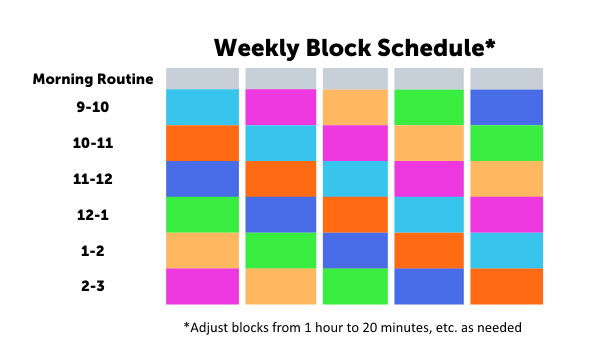
Routines provide predictability, a sense of boundaries, and reassurance. And whether it is work or for school, we all know that a sense of routine can help productivity; doesn’t matter one’s age!
Why should we embrace routines?
Structure shouldn’t be synonymous with the idea of restriction or loss of free will. Rather, structure and routine help guide expectations and give people (especially kids) a sense of control.
Schedules provide a sense of focus, help eliminate distractions, and provide consistency – all of which help us form habits; and we humans are habitual creatures. Yet nothing is normal right now, so throw your previous day-to-day expectations out the window…and create some new ones!
What can I do now?
Learn from your elders …
Steve Jobs and Benjamin Franklin started each day by asking themselves an essential question. Mozart, Ford, O’Keefe, and Gandhi embraced “morningness” by being early risers. Hemingway, King, and Grisham routinized their writing to keep up daily productivity. Beethoven, Darwin, and Dickens were walkers, fans of taking breaks. All of these accomplished folks found the power of routine.
The family that schedules together …
As a family, you need to determine new routines, together. Begin by reflecting on what parts of your pre-COVID19 schedule used to work well as a family unit. Take time to mourn how unpredictable things are today and how we’re all in this together. Then, consider creating a block schedule together for those in your home:
Begin by noting time-specific activities like meals; then factor in a couple of routinized breaks; and lastly, pencil in well-rounded activities that encourage personal achievement for each person, whether for work or for school.
Gimme a break …
Value a well-timed break for mental clarity and physical activity. A break can be as simple as a walk outside, as quiet as silent reading (DEAR: Drop Everything And Read), or as energizing as a flash dance. Use short breaks frequently to either unwind or burn energy. Such “brain breaks” can actually increase focus and productivity while reducing stress. A win-win!
I saw the sign …
Mimic a classroom by using visual cues to remind young children of the schedule. Move a clothespin down a sequenced list. Remove velcroed activity cards as you accomplish them throughout the day. And if your work schedule requires a “no-kid zone” for calls, hang a red sign on the door when they aren’t permitted to enter and a green sign when you welcome questions or a chat.
Don’t quit your daydream …
Embrace boredom! Every minute of every day can’t be stimulating. Kids especially need to learn how to self-soothe and self-entertain. Research has shown that boredom can encourage creativity and problem-solving. Boredom can lead to daydreaming, which can provide a valuable, and well-needed, mental break. So let your mind wander!
Unplug yourself …
Unplug from technology and strive for a balanced sense of screen time. But do recognize that you may have to give your family permission to bend the normal limits as we all are using technology for seemingly everything – from news to work to social interactions. And then remember to unplug yourself, figuratively too, and enjoy downtime with your loved ones before getting some scheduled, and well-deserved sleep!
Darri Stephens is a former member of Teach for America and a seasoned educator, with more than 10 years’ experience in Los Angeles and New York City public schools. She’s a published author, who has also worked for education-focused media companies including Nickelodeon, IMAX, EdSurge, and Discovery Education. With master’s degrees in education from both Harvard and Stanford, she’s passionate about creative curriculum development that pushes boundaries, especially considering the influx of today’s technologies. Her most recent positions as Senior Director of Content at Common Sense and Director of Education at Wonder Workshop underscore her love of instructional design, writing, and the ever-changing edtech world – so much so that she has now founded her own content consulting agency, Darrow Ink.
Categorized as: Tips for Teachers and Classroom Resources
Tagged as: Toolkit: Create a Plan, Trauma and Resilience

